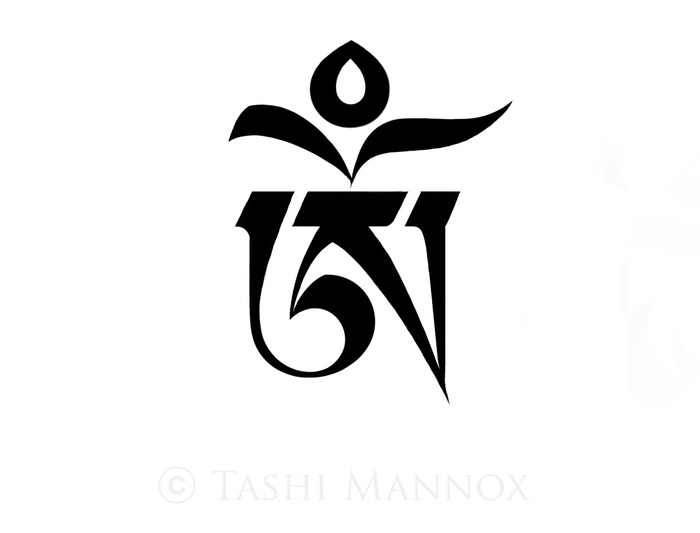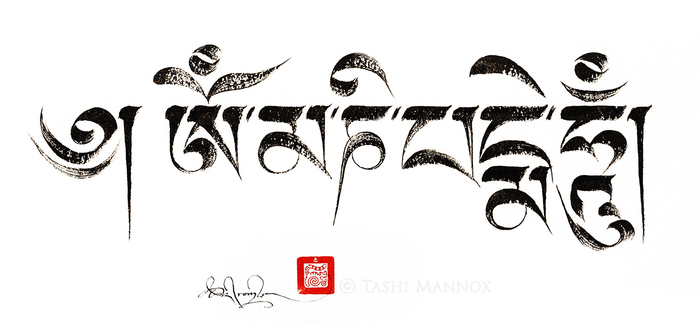Mantra. For some people, the word conjures up images of magical wish-granting syllables. Others think of chanting them as a form of prayer or devotion. Nowadays, political parties and commercial brands promote their “mantras” to us in the form of catchy slogans. None of this, however, is their intended use in Buddhist practice. In Buddhism, mantras are utilized as sophisticated tools to help us to generate and stay focused on beneficial states of mind, like compassion for others, or clarity of thought [See: What Is Buddhism?].
Mantras are phrases of words and syllables recited over and again as an aid to concentration on a beneficial state of mind, in order to protect the mind from negative states.
The Sanskrit word mantra is made up of its root, man, meaning “mind,” with the suffix -tra meaning “tool” – precisely describing the kind of “mind-tool” that mantras are in Buddhism. They are also found in all Indian spiritual traditions, and beyond as well. The Tibetans, for example, understood them as a form of “mind-protection,” a tool to protect the mind from disturbing thoughts and emotions.
Recited vocally or mentally, in or out of meditation, mantras help our minds to settle down and maintain mindfulness on a positive state [See: What Is Meditation?]. Here, mindfulness refers to an awareness that acts as mental glue, holding our attention to the mantra and its associated mental state, and preventing us from wandering off or becoming dull.

We can go further with mantra practice, using it to integrate our speech with our body and mind. For instance, if we’re going over to help or comfort someone and want to generate a strong emotional feeling of compassion (the wish for them to be free from their problems), we can recite the mantra OM MANI PADME HUM (possibly the most well-known of all Buddhist mantras) softly under our breath or in our minds. This keeps us focused on a feeling of compassion and prepares us to speak and act compassionately as we try to help.
Some mantras contain Sanskrit words mixed with syllables, while some just contain syllables. The words and syllables represent different aspects of the Buddhist teachings, like with this example of OM MANI PADME HUM:
- Om – this syllable is made up of the three sounds a, u and m, and represents both the body, speech and mind attained with enlightenment, and our ordinary body, speech and mind that first need to be purified of their deficiencies.
- Mani – this word means “jewel” and it refers to the first, or method side, of two factors that bring about the above purification. In this context, method is compassion, based on which we have the bodhichitta aim to attain enlightenment in order to benefit all beings as much as possible.
- Padme – this means “lotus,” and it represents the second factor, wisdom, an understanding of voidness. Voidness (emptiness) is the total absence of impossible ways of existing. Normally we project all sorts of nonsense concerning how we, others, and the world exist, but these projections do not correspond to reality. We believe these projections to be true, and so we become self-centered and unable to develop sincere altruistic compassion.
- Hum – this syllable indicates the indivisibility, here of method and wisdom, that will bring about enlightenment for the benefit of all.

However, this mantra, like most others, has different levels of meaning. One could make the practice of compassion even more effective by directing one’s meditation toward those suffering from specific problems, while reciting the mantra [See: What Is Compassion?]. Each syllable is correlated with one set of the major disturbing emotions:
- Om – pride and arrogance
- Ma – envy and jealousy
- Ni – desire, greed and attachment
- Pad – naive ignorance and stubborn closed-mindedness
- Me – stinginess and miserliness
- Hum – hostility and anger.
Then, a further step would be to elaborate on our compassion state of mind even further by remaining mindful of the six perfections (the six far-reaching attitudes), also correlated to the six syllables:
- Om – generosity
- Ma – ethical self-discipline
- Ni – patience
- Pad – perseverance
- Me – mental stability (concentration)
- Hum – discriminating awareness (wisdom).
Vocal recitation of mantras involves the breath, which from a Buddhist point of view, affects the body’s subtle energies. Even reciting mantras mentally can affect these energies. By giving a regular rhythm to the breath and subtle energies, mantra recitation can help to quiet compulsive disturbing thoughts and emotions, calm us down, and make the mind sharper and clearer.
A more advanced mantra practice, where we actually shape the breath and subtle energy, helps us to gain access to the subtlest level of mind. When this subtle mind is focused on voidness, it becomes an incredibly powerful – the most powerful – tool for ridding us forever of all unawareness and confusion about reality, and for bringing us to enlightenment. My principal teacher, Tsenshap Serkong Rinpoche, often used to say, “There are three most powerful things in this world that bring benefit to all beings: medicine, technology and mantras.” By mantras, he was referring to The Heart Sutra, which states that the perfection of wisdom (far-reaching discriminating awareness of voidness) is “the mind-protecting mantra that’s unsurpassed… the mind-protecting mantra completely stilling all suffering.”
There are a wide range of applications for mantra practice in Buddhism. As a start, they regulate the breath and subtle energies, allowing our minds to calm down. They then help us to stay focused on positive states of minds or emotions, like love and compassion. Furthermore, they help integrate and harmonize our body, speech and mind. Finally, through deeper practice, mantras help us to gain access to the subtlest level of mind with a focus on voidness, leading us to the actual attainment of enlightenment for the benefit of all.